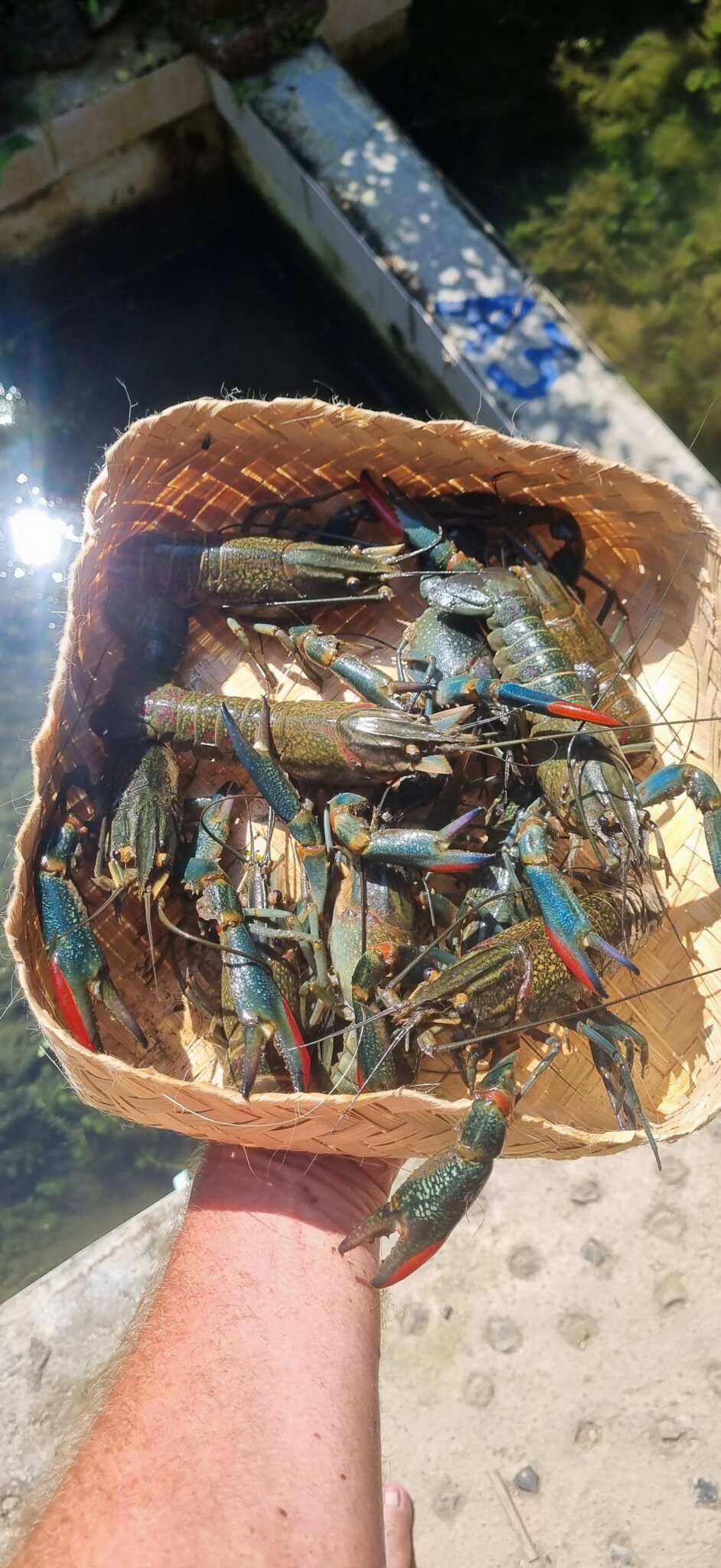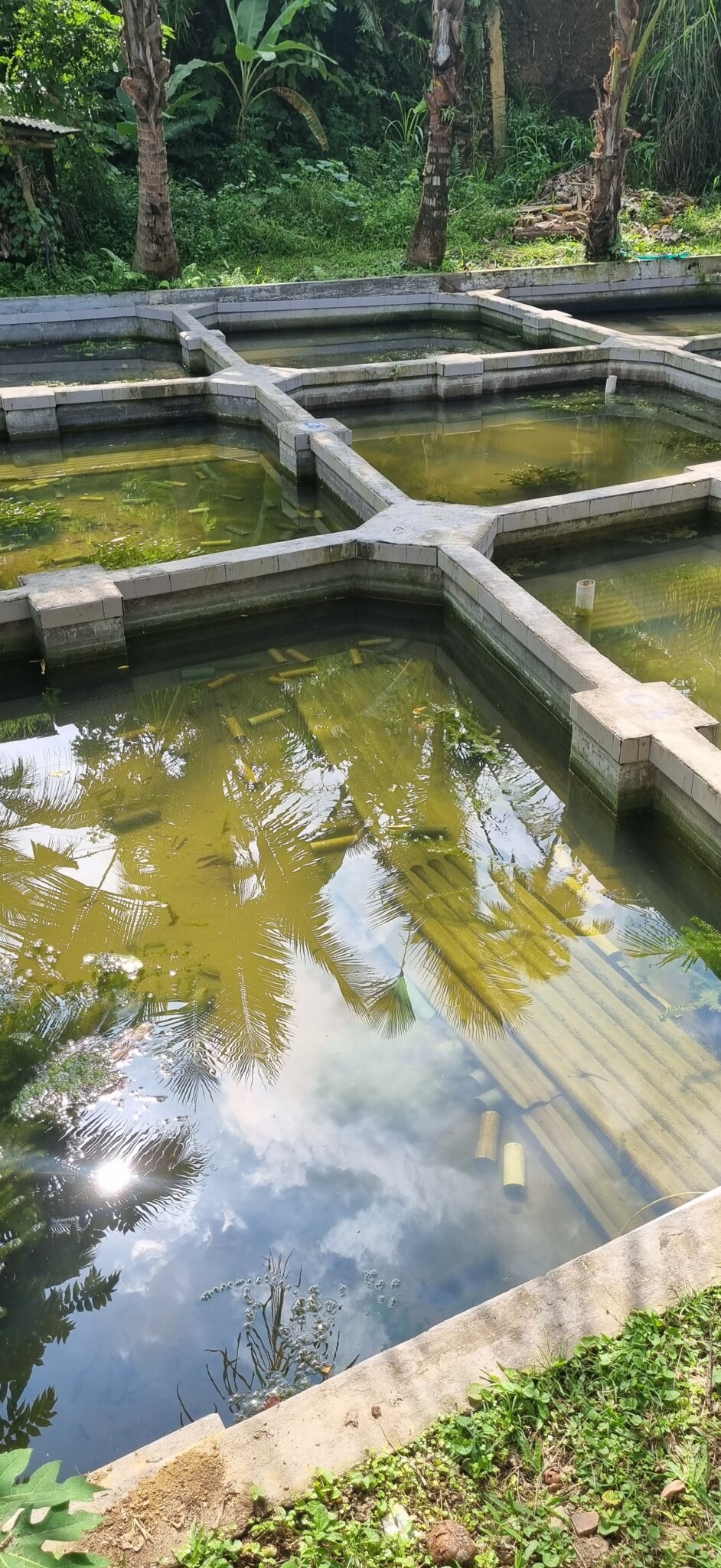
We first explored the lobsters to help out a local fish farmer who had gone bust thanks to covid. We had an escape route if it didn’t work out, but the more we understood the business, the better it seemed. And it fits so well with our ethos of high profits, lots of local involvement, export produce and ecologically sound.
They are Redclaw crayfish from northern Australia, a tropical species. Unlike most, they are social and non-aggressive, well suited to farming. The young fish hatches directly from the egg, with no larval stage, which is a characteristic of lobsters. Crayfish have a larval stage. In fact, the marine tropical lobsters eaten in SE Asia are actually crayfish… Of course, there are different definitions, but we feel this is more apt than marine or fresh, or simply size.
Nevertheless, we are slightly uncomfortable with the term lobster. As we are with crayfish, for they are too big for crayfish. We really need a new name… Any suggestions?
These were encouraging, with our Australian consultant causing us to build a dozen small concrete lined ponds, each individually receiving a minute flow of water. He supplied us with brood stock, and lots of babies. My one requirement was no pellets! Pellets price increases are a number one cause of bankruptcy in fish farmers and pellets are so bad for the environment. We built Black Soldier Fly structures and planted papaya. The lobsters lived in bare ponds with lots of pipes cut into 15cm lengths to live in. Additional feed came in the form of leaves and vegetables.
Problems arose with the first rainy season, when they died in droves. We worked out that it was a sudden temperature drop, and created nine deeper ponds, which reduced deaths. Not amongst the babies, though, more delicate. We also found a lot of deaths in moulting, which we thought might be diet, or pH. Now, we feel it is stress, caused by temperature drop and handling.
After a year, we were behind schedule, and the babies weren’t surviving in feasible quantities. A last-ditch experiment to enclose the hatching ponds in case something was eating them did not succeed, although we did reduce deaths a little as dragonfly larvae were a major predator.
Nevertheless, we were determined to succeed for by this stage, we had discovered that the lobsters have an enormous market – 100 tons per month in Singapore alone. We would need 500 operations like ours to fulfil that market. Which makes this a perfect operation to create a cooperative and provide ongoing business for 500 fish farmers. We already had an order for 2,000 lobsters per month which we could not deliver. With sadness, the consultant had to go back to Australia as we were over budget and we considered our options.
We drained the ponds, area by area, and put holes between the walls. This enables us to create one flow going through all the ponds - we have a river! Each pond we planted with local weed and we put a hundred lobster in one pond to test. Six weeks later, we first checked our mud ponds and they hadn’t really worked. Very hard to get the lobsters, for there were rocks in the mud. But our first concrete pond was choked with weed. We drained it, and the lobsters were much bigger than expected. Plus, very few deaths. Plus plus, babies where there shouldn’t be! No dragonfly larvae.
We realise that the weed is very beneficial for several reasons. First, the lobsters switch to eating it as their staple. We simply augment with BSF and worms, and a few fish. Secondly, it provides homes for them. Thirdly, natural oxygen in the water, we don’t need aerators. Finally, it keeps the water warmer.
We are in a slight quandary, though, for with adults in the pond, few dragonfly larvae, which indicates the lobsters are eating them. But we suspect they are partial to the odd baby lobster as well… The dragonfly larvae can empty a pond of baby lobsters, so we need to find a balance.
The switch to eating weed was evident when we put 300 lobsters into a pond half full of weed. Within two weeks the little beggars have eaten the lot. We’ve had to move them early to a new pond.

Have we solved all the issues? No. We are trying hatching in lots of weed, rather than bare ponds with artificial net hiding places. We want to cover the ponds before the rains come in September. We want to try running water through black pipe to heat the ponds, see if the increased temperature helps. We are testing different weeds.
We have identified growing Spirulina as a perfect food for young lobsters. This is because spirulina is an algae which builds the cell walls from protein, not cellulose. This is also why it is a hailed as a superfood for humans. Humans who don’t know that the primary food for spirulina is human urine…
At least it is organic!
We are trialling spirulina growth at present. Not easy, because it really likes to be ten degrees warmer than here, and also because the sample we have doesn’t seem to like it that hot!
We have an offer from the fisheries department to take over a fish farm on the shore, where the temperatures will be much higher. This will also mean much more pollution in the water, and we are hesitant. We are breeding a low temperature tolerant sub-species… by low temperature, I mean 23C!
We have started to sell the lobsters, Rp 30,000 for one of approximately 100g. This is because the lobsters go up about 20g when they change their skin, and it is tricky doing them by weight. Better by size, easier for restaurants as well. Minimum order is ten, with free delivery in the Ubud and Gianyar areas. We are looking at doing a tour of the vanilla gardens with a lobster lunch, not yet finalised. Watch the website. That will be an opportunity to taste them. Naturally, they are delivered in a woven bamboo basket.
The market for these lobsters is enormous. China is the world’s largest consumer of crayfish, eating 90% of the world’s production. Singapore, on our doorstep and hour and a half’s flight away, wants 100 tons per month. That’s two million dollars.
We have three challenges. Farming them in an ecological manner that is stress free, feeding them appropriately and building up a network of partner fish farms to work with us. We cannot do it alone. We estimate that we need at least 500 local fish farmers. Long term goals are to duplicate this in Manado for the Japanese market, Batam or Pontianak for the Singapore market. And to build a freezer unit in Bali.
We are nearly there. We are happy with the way we keep the lobsters. They are thriving in the large weed ponds. Not just that, but it makes feeding them so much easier. We can leave them to munch on the weed while we add tidbits designed to look after their mineral and vitamin needs. The beauty is that the operation once running is inexpensive, and can provide openings for many fish farmers. I look forward to the near future when we can work with the University to assist their students.
And it will make a great deal of money for those prescient souls who invested with us.
Rex Sumner
Chairman at PT Royal Spice Gardens
Royal Spice Gardens is an Indonesian Foreign Investment Company, in Indonesia known as a Perusahaan Modal Asing (PMA).
NIB Licence number 0220100502286. NPWP: 94.830.504.0- 905.000.
PT Royal Spice Gardens Indonesia, Jl. Raya Pejeng, Tampaksiring, Gianyar, Bali 80552, Indonesia
Website by Simia Solutions / Cre8 Design Studio
Powered by Pak Kriss’s Compliance Framework.
Even in uncertain times, credible, stable & realistic opportunities are available for the astute investor.
Get the edge by obtaining clear, concise and rapid information. Fill out the form to receive our latest prospectus!